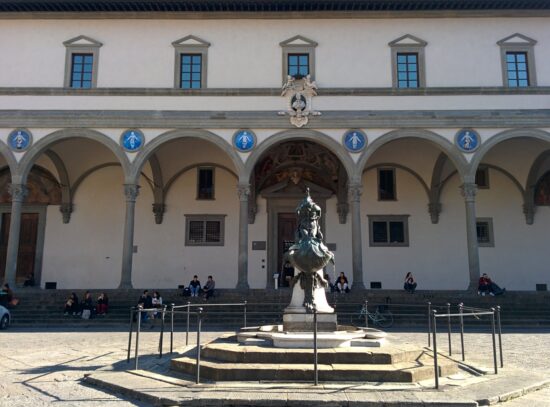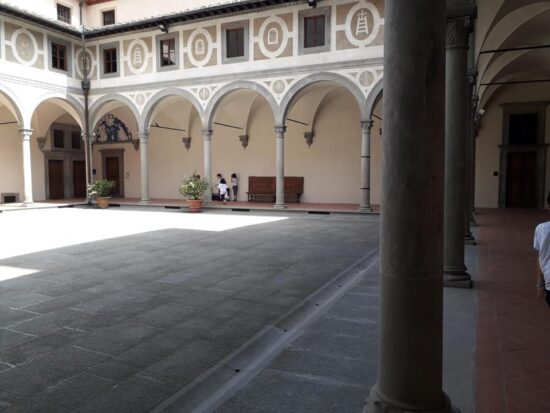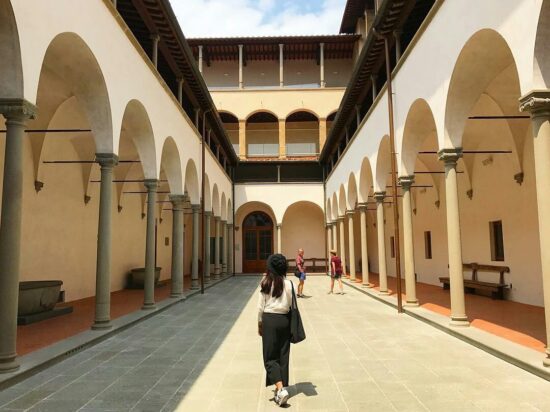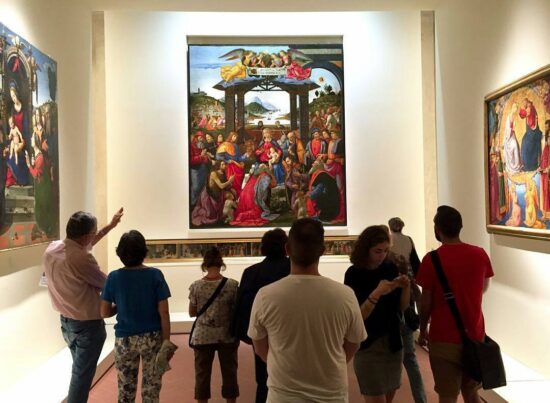Ospedale degli Innocenti
The Ospedale degli Innocenti is one of the first great architectural creations of the Renaissance. It represented a completely new concept in hospital design at the time. Based on the architecture of a palazzo, with a grand façade, loggia and graceful courtyards more in the style of an aristocratic residence rather than a public institution for the care of abandoned infants and children.
Before the end of the 1400s, the Spedale was accepting hundreds of children annually, for the most part illegitimate offspring of noble or wealthy citizens or the children of families too poor to care for them adequately. To ensure that people would not hesitate to bring children to the hospital for care and lodging, a practice of anonymity was instituted from the very beginning. Thus, initially, infants could be left in the pila, a basin near the main entrance.


In 1660, the pila was replaced by the rota, a circular, revolving container positioned in an opening in the wall near the entrance in such a way that an abandoned infant could be placed in it outside the building. The rota was permanently closed in 1875. Children were immediately baptized and then breastfed by resident wet nurses; many were later sent to wet nurses in the countryside and then placed in foster care until about 7 years of age, when they would be returned to the Spedale.
The boys were taught to read and write and, after two more years, were put up for adoption, usually as apprentices to craftsmen. The girls were placed as household servants or set to work in silk or wool production, washing and weaving cloth. A child in care at the Spedale in the 1400s might have spent as few as two years actually on the premises as the hospital officials attempted from the moment of admission, to provide children with a family setting.
Adoption and apprenticeship contracts, drawn up when children were older, stipulated that the children must be treated as if they had been the adoptive parents’ own sons or daughters. In their record-keeping, the personnel often referred to the institution as the ‘famiglia’ (family) or the ‘casa’ (home). At the height of its activity, the Spedale had more than 3,000 children in its care.
The Spedale continued to take in orphans during the first half of the 1900s. It was particularly active during both World Wars, offering shelter not only to orphaned children, but also to refugee families. Its function as a large residential care institution was terminated in the early 1980’s. The Istituto degli Innocenti now provides temporary shelter for local women and children at risk. It hosts a nursery school, a children’s crèche and pre-natal service.
The Istituto is developing new approaches to the provision of day care, basic education and assistance for children and families in distress. It serves the Tuscany Regional Government in an advisory capacity on these subjects. A vast archive contains records for all children cared for from the arrival of the first foundling in 1445. UNICEF and the Istituto degli Innocenti collaborate on a number of research projects and maintain a joint research library facility. (description by https://www.unicef-irc.org/)


After 2016 the building houses a new museum, the Museo degli Innocenti. The Museum of the Innocent offers extensive historic knowledge about the essence and activity of the institution for the past six centuries, integrating all of its documents and archives into individuals tales. The Museum’s uniqueness lies in the fusion of its integral elements, which are art, architecture and childhood history with its commitment to the protection and promotion of children’s rights.
The new Innocenti Museum offers a 1456 sq. ft. exhibition space on three levels and 1655 sq.m for temporary events and educational activities such as artistic workshops for children and families , temporary exhibitions , conferences and training activities. The basement floor tells the story of the evolution of the Innocenti Institute through biographies and personal memories of the nocentini – so they were called the children welcomed in the orphanage.
On the ground floor lies the architectural pathway, the evolution of the old hospital reconstruction, the subsequent renovations of the building and how the Institute’s function has evolved, adapting its spaces to the new needs. On the second floor is the gallery that houses the most valuable artwork. There are eighty works,by artists like Sandro Botticelli, Domenico Ghirlandaio, Bartolomeo di Giovanni, Piero di Cosimo, Neri di Bicci, Luca and Andrea della Robbia and Giovanni del Biondo.
The 15th-century terrace houses the Verone Café , open not only to museum visitors, but to the whole city: a flexible and transparent structure (glass and wood) able to shrink or expand its space depending on the weather conditions.
The process of making the museum is preceded and accompanied by a great work of study on the history of the institution and on the entire artistic and cultural heritage displayed. A research work that guided the restoration work of most of the historic building and about 50 works, including the 10 Putti of Andrea della Robbia on the facade.



